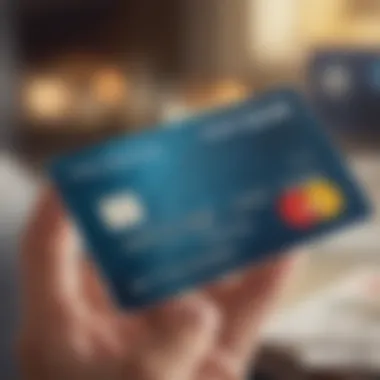Maximizing Benefits of Prepaid Visa Cards


Intro
Prepaid Visa cards have become increasingly popular among consumers looking for flexibility in managing their finances. These cards offer a unique way to make purchases without the hassle of traditional banking accounts or credit checks. Unlike standard debit or credit cards, prepaid cards require you to load funds onto them before use, making them an attractive option for many. They provide a safety net for overspending, allowing users to create a budget by limiting spending to the amount preloaded on the card.
This article aims to uncover the multitude of ways these versatile cards can be maximized for everyday use. From understanding the basic terminology surrounding prepaid Visa cards to discerning the costs and potential advantages tied to them, we will explore every facet that consumers should consider. Both seasoned financial managers and those just beginning to navigate their financial landscape can benefit from this comprehensive look.
As we progress, we’ll touch on essential tips and strategies for optimizing the use of prepaid cards, decision-making around expenditures, and common myths surrounding their utility. Using this guide, you’ll be equipped with the insights needed to leverage prepaid Visa cards in your financial toolkit.
Investment Terminology
Understanding the lingo associated with financial products is a crucial step toward becoming an informed consumer. With prepaid Visa cards, familiarity with some key terms can help you navigate their use more effectively. Below is a glossary of relevant terms that will aid in comprehending the nuances of these cards.
Glossary of Key Terms
- Prepaid Card: A type of payment card that is preloaded with a certain amount of money, which can be used to make purchases until the balance reaches zero.
- Reloadable: Refers to the ability to add funds to an existing prepaid card.
- Transaction Fee: A fee that may be charged for each purchase made with the card or when the card is reloaded.
- Expiration Date: The date after which the card will no longer be valid for use, requiring a replacement card.
- Balance: The amount of money currently available on the prepaid card.
Common Investment Acronyms
- ATM: Automated Teller Machine - Used for withdrawing cash from the card.
- PIN: Personal Identification Number - A security code used to access funds on the card.
- POS: Point of Sale - Location or terminal where transactions take place using the card.
With a grasp on these terms, users can feel more confident in managing their prepaid Visa cards effectively.
Financial Product Reviews
To maximize the use of prepaid Visa cards, it’s prudent to consider the various products on the market. Not all prepaid cards are created equal, and understanding their features can save users time and money.
In-Depth Product Analysis
Notable products in the prepaid Visa card space include the NetSpend Visa Prepaid Card and the Walmart MoneyCard. These cards offer different benefits, fees, and features:
- NetSpend Visa Prepaid Card: Known for its extensive online account management features, catering well to those who prefer digital banking. However, it may involve higher fees compared to other prepaid options.
- Walmart MoneyCard: This option is appealing for frequent Walmart shoppers offering cash-back rewards. The fees are relatively lower, but its use is most beneficial in conjunction with Walmart’s ecosystem.
Pros and Cons Overview
An honest assessment of prepaid cards can be beneficial.
Pros:
- Enhanced budgeting control, as you can only spend what you load.
- No overdraft fees—once your loaded funds are depleted, spending stops.
- Wide acceptance anywhere Visa is accepted.
Cons:
- Potential for high transaction fees that can erode your balance.
- Limited protections compared to credit cards; for instance, if lost or stolen, you might face challenges retrieving the lost funds.
"Prepaid cards can be a smart solution for budgeting purposes, but careful consideration must be given to the associated costs."
In selecting a prepaid Visa card, it's essential to weigh these pros and cons according to your financial lifestyle and spending habits.
The next sections will delve deeper into effective spending strategies and tips for better management of prepaid Visa cards.
Intro to Prepaid Visa Cards
In today's fast-paced financial landscape, prepaid Visa cards have carved out a niche that appeals to a variety of users. These cards represent a blend of convenience and control, making them a popular choice for many individuals and families. Whether it's for budgeting purposes, gifting needs, or simply a means of managing expenses, understanding the nuances of prepaid Visa cards is essential.
Prepaid Visa cards allow users to load a specific amount of money onto the card, which can then be spent until the balance reaches zero. This structure inherently encourages responsible spending; once the funds are depleted, individuals must reload the card or refrain from making additional purchases. This self-limiting feature can help people avoid the common pitfalls associated with debt accumulation often seen with credit cards.
Moreover, prepaid cards offer a level of accessibility that traditional bank accounts might not. They're widely accepted across various retailers and online platforms, bringing a sense of flexibility for those who might not qualify for a credit or debit card due to a lack of banking history.
Definition and Purpose
Prepaid Visa cards are essentially a type of payment card that allows users to manage their finances more intuitively. These cards are preloaded with funds, meaning users must load money onto the card before they can make purchases. This setup serves multiple purposes. It can help individuals control their spending within a specific budget, facilitate online shopping without exposing sensitive financial information, and act as a practical tool for those who prefer not to use cash or traditional banking services.
Being widely accepted at both in-person and online retailers, these cards can easily be integrated into an individual’s daily spending habits. Additionally, they can be useful for parents wanting to provide their children with a means to spend money responsibly.
Differences from Traditional Debit/Credit Cards
While prepaid Visa cards have similarities with debit and credit cards, there's a distinct difference in how they operate. Traditional debit cards are linked directly to a bank account, allowing users to draw from their account balance and potentially accumulate fees if overdrawing. Conversely, prepaid cards do not connect to an existing bank account; they draw solely on the amount loaded onto them.
Credit cards, on the other hand, enable users to borrow money up to a pre-set limit. This can lead to debt if not managed properly. Prepaid Visa cards completely sidestep this issue. Users can spend only what they have loaded, eliminating the risk of accruing debt due to overspending unlike on credit cards.
“Understanding the differences between these card types equips consumers with the knowledge needed to choose what best fits their financial needs and lifestyle.”
In summary, the choice between prepaid Visa cards and traditional debit or credit cards hinges on the individual's needs for financial control and spending habits. Recognizing these differences will empower users to make informed decisions about their payment options.
Understanding the Financial Aspects
Getting a grip on the financial layer of prepaid Visa cards is like seeing through the fog of everyday spending. Knowing how fees and reloading options work opens up new doors for savvy financial management. It’s not just a matter of loading money and swiping away; it’s about understanding the cost structure and being strategic about every dollar. By delving into the specifics of fees and reloading methods, you can make informed decisions that prevent unexpected surprises while using your card.
Fee Structures
Activation Fees


Activation fees often come into play when you first grab a prepaid Visa card. So, what are they? Essentially, it’s the upfront cost you pay to get the card rolling. This fee varies from card to card, and while it might seem like a nuisance, it’s often considered a small price to pay for the freedom it offers.
A significant advantage of activation fees is that they usually cover the cost of issuing the card itself—think of it as an initiation fee for accessing a new financial tool. Just remember, this fee should be factored into your initial budget, as it can cut into your available balance right off the bat.
Monthly Maintenance Fees
Monthly maintenance fees are like that pesky subscription you wish you could cancel but can’t. They’re charged every month just for the privilege of keeping your prepaid card active. This fee could be seen as a deterrent, but for some users, it may result in benefits that outweigh the costs, such as improved customer service or additional perks.
If you find yourself using the card regularly, the convenience this fee offers could be justified. Just keep an eye on your spending—mindless month-over-month charges can add up quickly, and you wouldn't want to discover that your balance is flatter than a pancake.
Transaction Fees
Transaction fees are where it gets a bit more complicated. Every time you make a purchase or pull out cash, you might be looking at yet another charge. However, these fees can vary greatly depending on the type of transaction and where it is processed.
These fees can often be viewed as a downside, especially if you're using your card frequently. But on the flip side, understanding them enables you to plan purchases better—knowing when and where fees apply can help you avoid unnecessary expenses, turning what could be a burden into a manageable aspect of spending.
Reloading Options and Costs
Reloading options are crucial—they dictate how you can add funds back onto your prepaid Visa card. Each method carries its own set of pros and cons, bringing us to three main options: in-store reloading, direct deposit reloading, and bank transfer reloading.
In-Store Reloading
In-store reloading is basically as simple as it sounds—you go into a participating retailer, and voila, you load cash onto your card. Many people love this option for its convenience. You can toss cash onto your card while picking up groceries or running errands. On the downside, it might not be the most cost-effective method. Stores often impose a reloading fee, which can eat into the funds you just added.
The key to leveraging this method is to check the fees beforehand. If a store charges you five bucks to load fifty, you might reconsider your choices.
Direct Deposit Reloading
Direct deposit reloading is a real game changer. If you've got a paycheck or government benefits, you can have those funds directly deposited onto your prepaid card. It’s as smooth as a hot knife through butter—no fees for loading your paycheck, and it’s almost instantaneous.
That said, if you’re not employed or don’t receive regular payments, this method might not be useful for you. But for those who do, it’s likely the best choice for reliable and cost-effective reloading.
Bank Transfer Reloading
Lastly, bank transfer reloading offers yet another way to keep the funds flowing. Linking your prepaid Visa card to your bank account allows you to transfer money back and forth. This method is particularly handy if you have an online bank account. It might take a bit longer than direct deposit, but the ability to load and withdraw funds flexibly can be worth the wait.
However, bank transfer reloading generally comes with its set of challenges. Some banks may charge fees for each transaction, so it pays to know your bank’s policies. All in all, understanding these aspects is part of playing smart with your money.
Where and How to Spend Prepaid Visa Cards
Understanding where and how to spend prepaid Visa cards is pivotal in maximizing their utility. These cards are more than just a means to access funds; they provide a structured approach to managing spending while granting the flexibility typical of a Visa card. The main aspect to consider is that these cards can be used much like traditional credit or debit cards but are limited to the amount preloaded onto them. This limitation inherently helps in maintaining financial discipline, as users can't overspend their set limits. Let's delve deeper into the various spending avenues available.
In-Person Retail Purchases
Understanding Merchant Acceptance
Merchant acceptance is a key element when it comes to using prepaid Visa cards in physical stores. Most retailers, from large chains like Walmart to local shops, accept these cards. This widespread acceptance makes the card an attractive option. Customers can easily check for acceptance before shopping, ensuring they won’t end up disappointed at checkout.
A noteworthy characteristic of merchant acceptance is that it allows for both online and offline usability. Since these cards are backed by Visa, acquiring goods and services from a range of merchants becomes a seamless experience. However, it is wise for users to be aware of potential restrictions in some specific stores, which may not accept prepaid cards due to their own internal policies.
"Spending wisely with prepaid Visa cards not only prevents overspending but also encourages budgeting habits."
Using Card at Point of Sale
Using a prepaid Visa card at the point of sale mirrors the experience of using a conventional credit card. In most cases, customers simply swipe or insert the card, and the amount is deducted from the card’s balance. This straightforward process simplifies transactions, reducing wait times unlike cash or checks which may take longer.
One unique aspect of using cards at points of sale is the instant nature of the transaction. Users can easily keep track of their spending on-the-spot, which promotes better financial awareness. On the downside, users must remain vigilant and ensure they have enough balance to complete a purchase, or else they might face transaction declines.
Online Shopping
Preferred E-commerce Platforms
When it comes to online shopping, several e-commerce platforms gladly accept prepaid Visa cards. Well-known sites like Amazon and eBay provide the option to use these cards, making it accessible for consumers to purchase a range of goods—from electronics to clothing—without the need for a banking account.
The main advantage here is the convenience and flexibility of spending online without linking to a primary financial account. However, users may encounter some niche retailers where prepaid cards are not accepted, which can be a stumbling block for spontaneous purchases. Thus, checking payment options beforehand is essential for a smooth shopping experience.
Authentication Processes
Security measures are vital in online shopping, and authentication processes play a significant role in safeguarding prepaid Visa card transactions. When making a purchase, many sites require additional verification, like entering a security code or confirming via email. This practice not only protects users from fraud but also builds confidence in online transactions—a crucial factor in e-commerce today.
Although these processes add an extra step, they offer peace of mind, knowing your funds are secure. However, managing multiple authentication steps can sometimes be cumbersome, leading to an unfriendly user experience if not executed well.
Recurring Payments and Subscriptions
Setting Up Automatic Payments
Setting up automatic payments using a prepaid Visa card is an efficient way to manage recurring expenses like utility bills or software subscriptions. Most service providers offer the option to link the card, allowing users to set their payment date and amount. This automated approach ensures bills are paid on time while minimizing the risk of late fees.
The flexibility of controlling the spending limits on a prepaid card makes this option especially attractive. However, users should monitor their balances regularly to prevent accidental declines in payments, which could disrupt services.
Managing Subscription Services
For those who utilize various subscription services, managing them with prepaid Visa cards helps keep finances in check. It’s beneficial for users to understand what services are drawing funds regularly, so they can assess their importance and adjust their budgets accordingly. Plus, it provides a great way to limit spending, as the card cannot be charged beyond its limit.


Still, cancellation policies can differ. If users decide to discontinue a service, they must keep track of when they set up payments to avoid any unwanted withdrawals. Keeping organized notes or reminders can help in this respect.
Budgeting with Prepaid Visa Cards
Budgeting is a fundamental skill that allows individuals to take control of their finances. When it comes to using prepaid Visa cards, creating a budget becomes even more essential. Prepaid cards can help in sticking to a budget, as they allow users to load a specific amount of money, making it harder to overspend. Understanding how to effectively budget with these cards not only aids financial discipline but can also reduce stress when managing day-to-day expenses.
Establishing Spending Limits
Creating a Budget Framework
Creating a budget framework is vital for anyone looking to stay on top of their finances. It serves as a structured approach to spending, ensuring that individuals know exactly how much they can allocate to various expenses. This alignment helps prevent the common pitfall of impulse shopping or unnecessary purchases. A solid budget framework allows for a clear delineation between what is essential and what is discretionary.
Every successful budget framework identifies fixed and variable costs, categories where spending might occur, and a maximum allocation for each. In the case of prepaid Visa cards, users can set a predetermined amount to load onto the card based on their budget. This automatic limitation acts as a push to maintain financial discipline, making this approach a popular choice. The unique feature is its simplicity; users know the card balance and can only spend what’s already there, thereby avoiding debt.
However, one disadvantage might surface: if not well-planned, the budget could ignore unforeseen expenses, leading to frustration when the prepaid card runs low. Therefore, a budget framework must be flexible enough to accommodate unexpected costs.
Tracking Expenses Effectively
Tracking expenses effectively is another crucial aspect of budgeting. It allows users to monitor their spending in real-time, ensuring they are within the confines of their budget. Unlike traditional checking accounts, prepaid Visa cards can sometimes lead to a disconnect if users don’t track how much they’ve spent. Keeping tabs on expenditures fosters awareness of spending habits.
Many find that maintaining a physical or digital record of transactions enhances accountability. The key characteristic of tracking expenses is its proactive nature, urging users to reflect on their spending choices regularly. With prepaid Visa cards, this can be a beneficial practice as it is often easy to lose sight of how much is left after a few purchases.
A unique aspect of effective expense tracking is its potential to point out spending patterns—like always grabbing coffee from the same shop or frequently buying snacks—which might need reining in. However, there is a downside: if one is lax about maintaining records, tracking can become a chore, potentially leading to gaps in understanding financial whereabouts.
Monitoring and Managing Balances
Effective balance monitoring is an integral part of using prepaid Visa cards responsibly. It ensures that users know how much money is available at any moment. Regularly checking balances can prevent running into situations where the card declines due to insufficient funds.
Utilizing Mobile Apps
Utilizing mobile apps for prepaid Visa cards has gained popularity due to convenience and real-time access to account details. These apps allow users to track transactions, review spending patterns, and check balances without much fuss. A key characteristic of these applications is their user-friendly interfaces, which often notify users of recent transactions and spending categories.
This approach is appealing because it allows users to stay on top of their finances, fostering an understanding of where money goes. A unique feature found in many apps is spending categorization, which helps users break down their expenses visually, aiding in better decision-making. On the downside, reliance on technology may pose security concerns or present challenges for individuals less comfortable with mobile banking.
Understanding Balance Alerts
Understanding balance alerts can significantly impact financial management when using prepaid Visa cards. Many card issuers provide alerts that notify users when their balance falls below a specified amount. This feature is particularly helpful because it maintains awareness of remaining funds and prevents overspending.
The beauty of balance alerts lies in their immediacy; they can prompt users to reevaluate their spending before they hit a dead end. For those who tend to forget to check their balances regularly, these alerts act as a safety net. However, there can be drawbacks. If alerts are set too liberally, users may become desensitized to them and ignore the notifications altogether, reducing their effectiveness.
By budgeting wisely and effectively utilizing prepaid Visa cards, individuals can gain financial control that can lead them to improved overall money management.
Benefits of Using Prepaid Visa Cards
Financial Control and Discipline
One of the standout features of prepaid Visa cards is their ability to foster financial discipline. Unlike traditional credit or debit cards, these prepaid options are controlled by the funds already loaded onto them; once the balance hits zero, spending stops. This principle brings a kind of simplicity that many find refreshing.
By using prepaid Visa cards, individuals can set specific spending limits before they even hit the checkout line, which inherently promotes a tighter grip on financial habits.
- Budgeting Made Easier: Users can load a set amount, making it easier to manage daily or monthly expenses. Sticking to a budget becomes less of a chore.
- Reducing Impulse Buys: With a finite amount available, the temptation to overspend on whims diminishes.
Moreover, prepaid cards can effectively serve as a gateway to managing overall finances each month. Almost like putting oneself on a cash diet, they help break down larger expenses into more manageable portions.
In a world filled with debt-draped warning bells, having a tool that fosters accountability is invaluable.
“Financial literacy is not just a skill; it’s a form of empowerment,” advocates often say, emphasizing how tools like prepaid Visa cards can lead to better financial decisions.
Accessibility for Non-Bank Customers
Another significant benefit of prepaid Visa cards is their accessibility. Individuals who might not have a conventional bank account—due to various reasons, such as credit scores, or simply because they prefer not to use traditional banks—can still enjoy the convenience of electronic payments.
This facilitates numerous opportunities, particularly for those who find themselves on the fringes of the banking system:
- Easy to Obtain: Many retailers offer prepaid cards without the need for a credit check, making it straightforward for anyone to access one.
- Universal Acceptance: Most prepaid Visa cards are accepted at a wide array of outlets, both online and in-store. They allow users to participate in the economy without the traditional banking connotations.
- No Hidden Surprises: Users don’t have to worry about overdraft fees or unexpected charges, which can often take unsuspecting bank customers by surprise. Everything is upfront and clearly delineated.
For many individuals, particularly students or those who are new to managing their finance, prepaid Visa cards provide a non-intimidating entry into the world of money management without the complexities associated with mainstream banking.
Common Misunderstandings
Understanding common misunderstandings surrounding prepaid Visa cards can significantly enhance one's ability to utilize these financial tools effectively and improve financial management. Many people hold misconceptions that limit their appreciation of the benefits available through these cards. Addressing these misunderstandings not only helps in making informed decisions but also empowers users to maximize their prepaid Visa card experience.
Misconceptions About Usage
Acceptability in International Markets
One common misconception is the belief that prepaid Visa cards are not accepted widely in international markets. In reality, prepaid Visa cards are linked to the Visa network, making them usable in a vast number of countries and establishments. This broad acceptance is a key characteristic that positions prepaid cards as a beneficial spending tool for those traveling abroad or engaging in online shopping from foreign merchants.
Key characteristic: The ability to make purchases anywhere Visa is accepted.
Unique feature: Many prepaid Visa cards come with multi-currency options, which can save on conversion fees.
Advantages: This makes them a popular choice for travelers who want financial control without carrying large amounts of cash.
Disadvantages: However, it's important to check that the specific card can be used internationally, as some may have usage restrictions or additional fees.


Perceived Security Risks
Security is another area where confusion often arises. A prevalent belief is that prepaid Visa cards are less secure than traditional credit cards, leading to hesitance in their use. Yet, these cards frequently come equipped with robust security features, such as chip technology and fraud protection measures, ensuring that users' funds are safeguarded.
Key characteristic: Enhanced security protocols that mimic those of credit cards.
Unique feature: Many cards allow users to monitor transactions in real-time through mobile apps, providing peace of mind that can ease security concerns.
Advantages: This bolstered security is essential for users, especially when compared to cash, which offers no recourse if lost or stolen.
Disadvantages: Nonetheless, it’s vital to practice vigilance and understand the steps for reporting lost or stolen cards, as failing to do so could lead to unnecessary complications.
Comparative Analysis with Other Payment Methods
Prepaid Cards vs. Credit Cards
When considering prepaid cards, it's useful to distinguish them from credit cards. Unlike credit cards, prepaid Visa cards are funded upfront with cash, thus eliminating the risk of accumulating debt. This feature contributes significantly to financial discipline and can be particularly appealing to those aiming to manage their budgets tightly.
Key characteristic: No possibility of overspending, as funds are not borrowed but preloaded.
Unique feature: Additionally, prepaid cards often come with lower fees compared to credit cards, such as annual fees or interest charges.
Advantages: This makes prepaid cards a more straightforward and safe option for everyday purchases.
Disadvantages: However, prepaid cards do not build credit history, which could be a drawback for individuals looking to improve their credit scores.
Prepaid Cards vs. Cash
Lastly, comparing prepaid cards to cash reveals further misunderstandings in their value. Cash, while universally accepted, lacks the convenience and security features associated with prepaid Visa cards. When you lose cash, it's gone—out of sight and out of reach. Prepaid cards offer a digital safeguard against loss and theft, and many come with fraud alerts that cash simply cannot provide.
Key characteristic: Digital tracking and transaction history with prepaid cards.
Unique feature: Users can reload and manage their funds from various sources, unlike cash, which is static once spent.
Advantages: This enhances not only security but also the ability to budget effectively through tracking expenses.
Disadvantages: However, the accessibility of cash remains unmatched, particularly in some small, local businesses that may not accept cards, necessitating a mixed approach to spending.
Future of Prepaid Visa Cards
The future of prepaid Visa cards holds significant importance in the realm of personal finance. As technology evolves at a breakneck pace, these cards seem to adapt alongside, providing unique opportunities for users to manage their funds better. The heightened interest from various demographic groups further emphasizes the utility of prepaid Visa cards, making understanding their future a vital aspect for anyone looking to navigate today’s financial landscape effectively.
Emerging Trends
Digital Integration
Digital integration is reshaping how prepaid Visa cards are used in everyday life. With everything moving towards digital platforms, being able to link a prepaid card with mobile payment systems like Apple Pay or Google Wallet is becoming the norm. This trend contributes significantly by allowing users to make quick transactions without always needing to carry a physical card. The key characteristic here is convenience. Integrating your prepaid Visa card with digital wallets allows for seamless transactions, making it a popular choice among tech-savvy consumers.
One unique feature of digital integration is the ability to track spending in real time. This offers a clear advantage: users can see where their money goes right on their phones. However, it is important to note that some folks may feel overwhelmed by technology, leading to potential misuse or accidental overspending if they do not keep a close eye.
Enhanced Security Features
Security remains a primary concern for users of all types of financial products. Enhanced security features in prepaid Visa cards are pivotal in building user trust. For instance, many cards now come equipped with chip technology and two-factor authentication, ensuring that sensitive information is protected. The key characteristic of this aspect is protection against fraud. These measures gear them toward being a safer option for anyone wary of traditional banking systems.
A unique feature of these security improvements is transaction alerts, which notify users whenever their cards are used. This can be a double-edged sword, alas; while it certainly reduces fraud risk, a constant stream of alerts might lead to notification fatigue. Furthermore, not all users might grasp the full scope of these features, which could leave some at a disadvantage.
Predictions for Usage Growth
Market Expansion
Looking ahead, market expansion for prepaid Visa cards shows promising potential. Businesses are recognizing the value of offering prepaid cards as rewards or payment options. This increasing acceptance is a strong indicator of their feasibility in mainstream society. The notable characteristic of this expansion is accessibility, as more retailers adopt these cards for payments and incentives.
A unique aspect to consider is the rise of niche markets, such as unbanked individuals or younger consumers who prefer cashless solutions. Although this is beneficial for promoting financial inclusion, the fast-paced nature can overwhelm those unused to digital tools.
Innovative Spending Solutions
Innovative spending solutions are setting the stage for prepaid Visa cards to become integral to personal finance management. Features like budgeting tools directly linked to card usage offer users a fine-tuned approach to tracking expenses. The core characteristic of this approach is flexibility, allowing users to adjust spending to fit their financial goals.
The unique attribute of these innovative solutions includes automatic savings features that round up transactions to save the spare change. While undeniably a beneficial addition for impulse savers, one must tread lightly since automatic settings can lead to complications if users don’t customize their parameters accordingly.
Epilogue
Through examining emerging trends and growth predictions, it’s clear that prepaid Visa cards will continue to find innovative and relevant ways to enhance user experience while addressing contemporary financial challenges. Keeping abreast of these changes can lead to maximizing the benefits these cards offer.
Ending
In this article, we've navigated through the world of prepaid Visa cards, shedding light on their multifaceted applications and the practical intricacies of using them. A key takeaway is the versatility of these cards, which provide a structured approach to managing one's finances. Whether it's budgeting effectively, spending wisely, or accessing funds without a traditional banking setup, prepaid Visa cards serve as an invaluable tool for an array of users, from students to seasoned professionals.
Recap of Key Points
To summarize, here are the essential elements we've discussed:
- Definition and Purpose: Prepaid Visa cards provide a convenient way to manage spending without the risk of overspending associated with credit cards.
- Financial Aspects: We touched on fees associated with these cards, including activation, monthly maintenance, and transaction costs. Reloading options can also influence overall use.
- Spending Strategies: It’s important to know where these cards are accepted, including online platforms and physical stores, alongside understanding how to set up recurring payments.
- Budgeting Techniques: Establishing limits and monitoring balances helps users maintain control over their finances.
- Benefits: Enhanced financial discipline and accessibility for those without bank accounts are significant advantages of using prepaid cards.
- Misunderstandings: Clarified common misconceptions regarding the security and usability of these cards in international markets.
- Future Trends: Discussed the potential growth in the market and integrating technology for enhanced security and user experience.
Overall, those key points underline not just the functionalities of prepaid Visa cards, but also their potential in modern financial management.
Encouragement for Thoughtful Utilization
To truly maximize the benefits of prepaid Visa cards, users should approach them with a strategic mindset. It's about making informed choices – from selecting the right card to tracking spending diligently. Such an approach can lead to greater financial awareness and control.
Investors and financial professionals alike will find value in this understanding, as it positions prepaid Visa cards not merely as temporary solutions but as integral tools in a broader financial strategy. As you move forward, consider how these aspects can fit within your personal or professional budgeting frameworks.
Moreover, as this landscape continues to evolve, staying updated on trends and emerging technologies will be crucial. The goal is to leverage these insights for making decisions that align with both immediate needs and long-term financial objectives.
Ultimately, a thoughtful approach to using prepaid Visa cards can empower individuals to navigate their spending with confidence, harnessing the flexibility these cards offer while avoiding common pitfalls associated with unchecked expenses.





